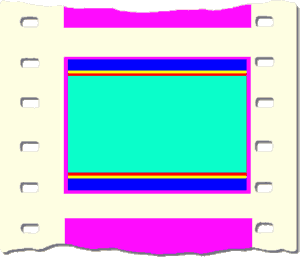
Camera Aperture - .864" x .630"
1.37:1 Aperture - .825" x .602"
1.66:1 Aperture - .825" x .491"
1.75:1 Aperture - .825" x .471"
1.85:1 Aperture - .825" x .446"
In 1931, the American motion picture studios adopted a new standard image size for 35mm sound films. The aspect ratio was 1.37:1, only slightly different than the larger 1.33:1 silent ratio frame that had been used for almost three decades. The camera aperture was standardized at .864" wide by .630" high. Projector apertures must be slightly smaller, and the standarized dimension was .825" wide by .602" high. The industry never really was comfortable with this nearly square shape, but with the failure of wide film systems in 1929-1930 and the tens of thousands of theatres already using a screen of this shape, the aspect ratio was set in stone. But the stone softened in 1953.
 | Camera Aperture - .864" x .630" |
1.37:1 Aperture - .825" x .602" | |
1.66:1 Aperture - .825" x .491" | |
1.75:1 Aperture - .825" x .471" | |
1.85:1 Aperture - .825" x .446" |
As is obvious from the illustration above, the wide screen image is created by reducing the vertical dimension of the projector aperture. This results in increased visible grain, scratches, and dirt, plus lower screen light levels. Ever improving film stocks have helped the grain problem.
During production, the camera aperture can be the full 1.37:1 Academy dimension or "hard matted" to a reduced height.
 | Current Anamorphic Aperture |
Camera Aperture - .864" x .732" | |
2.4:1 Aperture - .825" x .690" | |
| Pre-1957 Anamorphic Aperture | |
Camera Aperture - .937" x .735" | |
2.55:1 Aperture - .912" x .715" (4-track magnetic sound) |
From 1957 through today, there have been a number of small changes to the anamorphic projector aperture recommended standards. John P. Pytlak of Eastman Kodak dug through countless back issues of the SMPTE Journal in order to provide the following chronology of the changes to the standards:
The March 1957 SMPTE Journal has PH22.104-1957, the standard for 2.55:1 anamorphic (no optical track), with an aperture size of 0.912 X 0.715 inches. Notice of withdrawal of this standard was in the January 1964 Journal.
The December 1957 SMPTE Journal has PH22.106-1957 for 2.35:1 anamorphic, with an aperture of 0.839 X 0.715 inches. It was unchanged in the September 1964 Journal. The November 1965 SMPTE Journal published PH22.106-1965 still with the 0.839 X 0.715 aperture size.
In the September 1970 SMPTE Journal, a new draft of PH22.106 was proposed, with an aperture size of 0.838 X 0.700 inches, to minimize the flashes at splices. This was republished as standard PH22.106-1971 in the October 1971 issue.
In the June 1976 SMPTE Journal, the two (flat and scope) projectable image area standards (PH22.58 and PH22.106) were consolidated into one standard and renamed PH22.195. The publication of PH22.195-1984 in the October 1984 Journal still had the scope area as 0.700 X 0.838 inches.
The June 1992 SMPTE Journal published a proposed revision, with a scope area of 0.690 X 0.825 inches. In August 1993, the standard was published as SMPTE 195-1993, with the current area of 0.690 X 0.825 inches. So August 1993 is when the two formats became the same width of 0.825 inches.John P. Pytlak
See Also EVOLUTION FROM ACADEMY APERTURE Return To The Lobby
Return To The Entrance
E-mail the author
CLICK HERE©1997 - 2000 The American WideScreen Museum
http://www.widescreenmuseum.com
Martin Hart, Curator